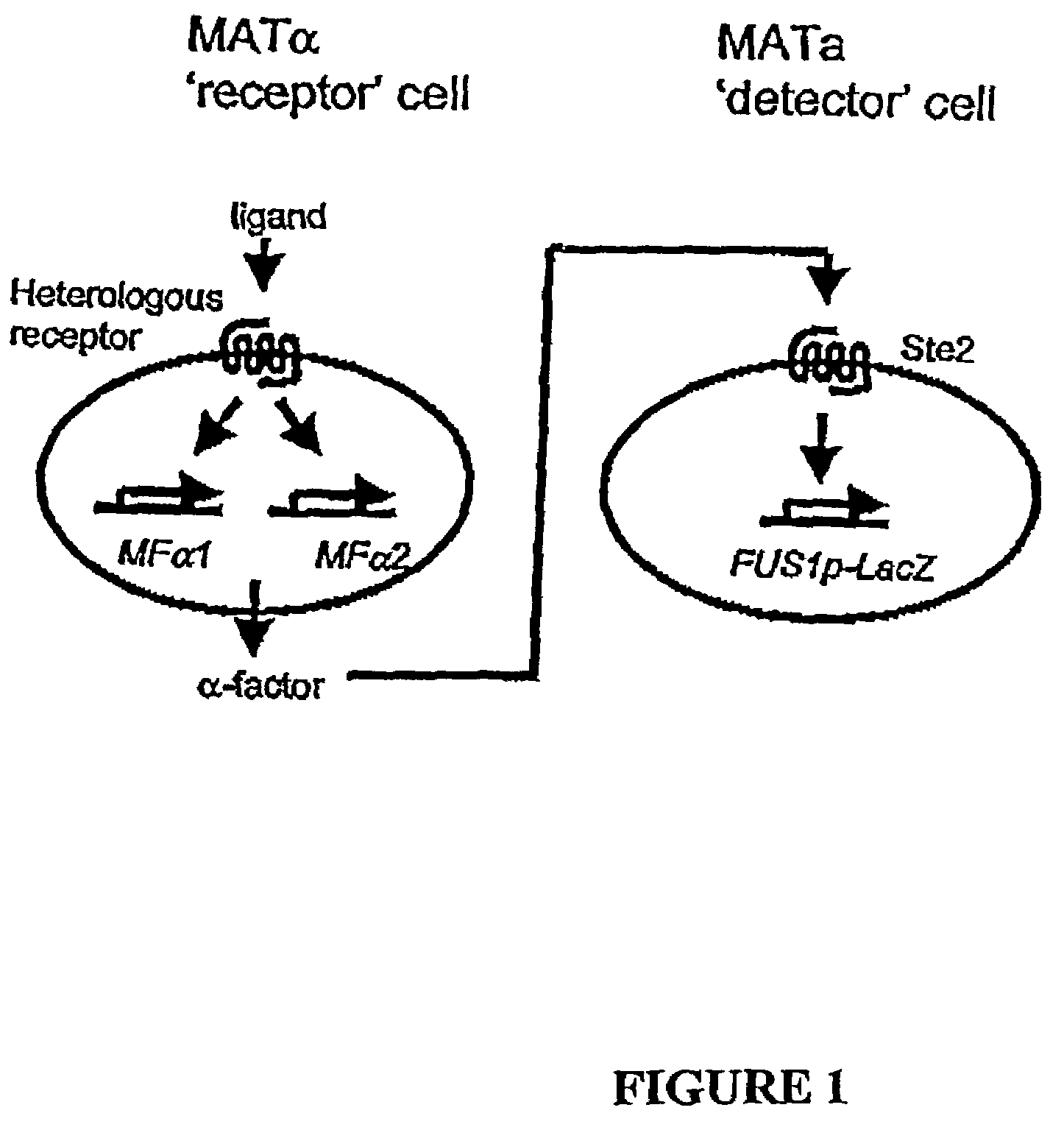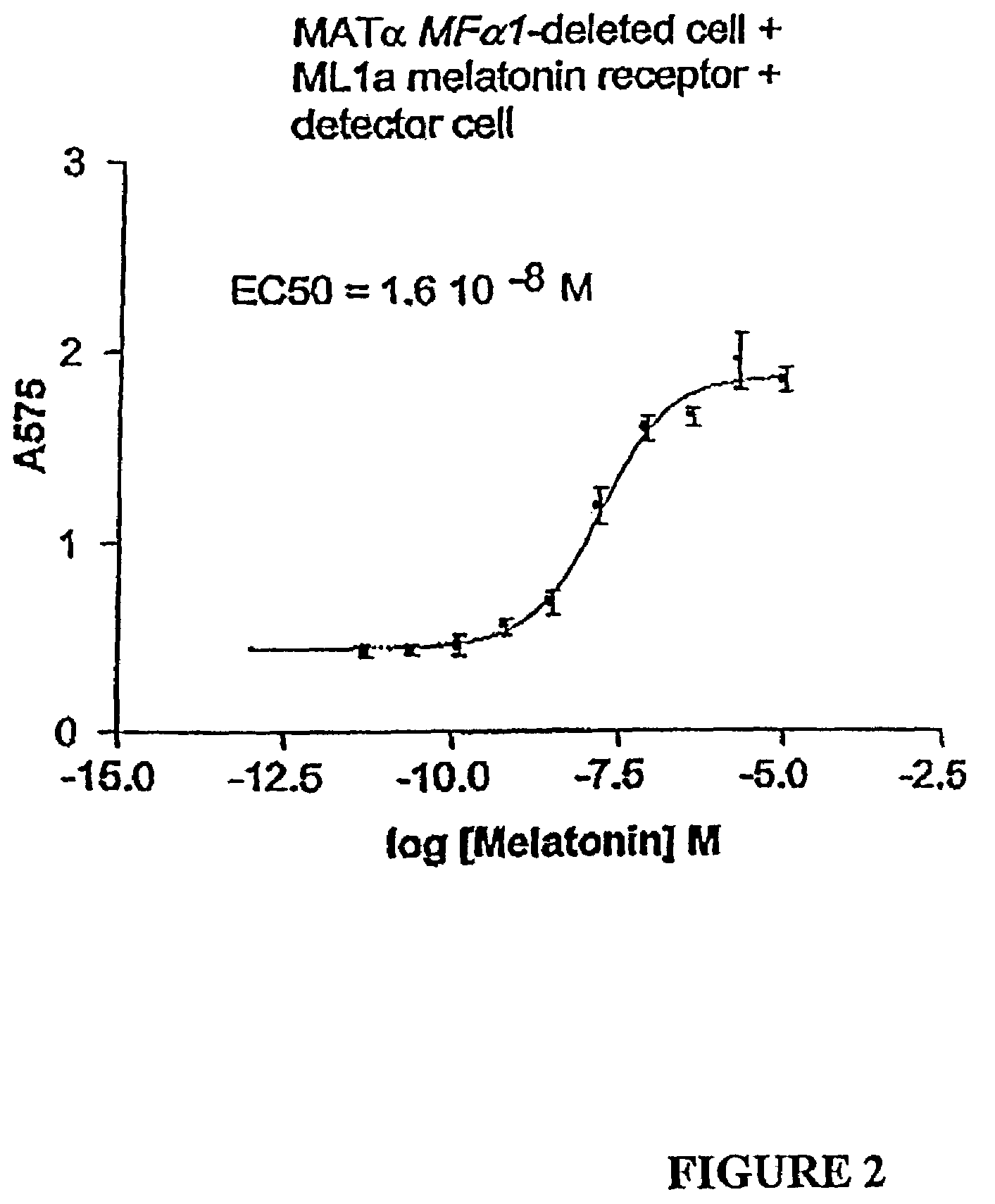System for detection of a functional interaction between a compound and a cellular signal transduction component
a functional interaction and signal transduction technology, applied in the field of system for detection of the functional interaction between a compound and a cellular signal transduction component, can solve the problems of labor-intensive and extremely expensive use of whole animals, and achieve the effect of high sensitiveness
- Summary
- Abstract
- Description
- Claims
- Application Information
AI Technical Summary
Benefits of technology
Problems solved by technology
Method used
Image
Examples
example 1
Detection of Ligand Activation of Pheromone Response Pathway Using Two Cell Assay System
[0167]This example demonstrates the utility of the assay system of the present invention for the detection of the activity of the mating factor response pathway in response to activation of a pathway-coupled receptor by its cognate ligand. Similarly, this system can be used to determine the agonist or antagonist activity of a test compound for a given receptor coupled to the aforementioned pathway, and also to identify ligands for orphan receptors coupled to this pathway.
[0168]As depicted in FIG. 1, the assay system comprises a first, test MATαS. cerevisiae yeast cell having a heterologous G protein-coupled receptor functionally coupled to the pheromone response pathway and a second, detector MATa S. cerevisiae yeast cell having a lacZ reporter gene fused to the FUS1 promoter. Binding of cognate ligand to the heterologous receptor in the test cell activates the receptor, causing a signal to be tr...
example 2
Deletion of the MFα1 Gene in Receptor Cells
[0176]One of the results of Example 1 was the finding that MATα ML1a-expressing test cells not stimulated with melatonin (and thereby not activating the pheromone response pathway) still secreted a considerable amount of α-factor. This constitutive expression and secretion of α-factor is disadvantageous, because weakly activating cognate ligands of the receptor in the detector cell may not stimulate a significant enough release of α-factor to be detectable over constitutive α-factor production. Data available in the literature suggest that the MFα1 and MFα2 genes are transcriptionally induced to different degrees (see Table 3) by stimulation of an a mating type cell with a-factor. Thus, experiments in which one of the two α-factor genes (MFα1) was deleted were undertaken in an attempt to lessen this background α-factor expression.
[0177]The percentages of contribution of each of the two mating factor genes to overall mating factor production...
example 3
Induction of Mating Factor Production in MATα Receptor Cells Deleted for the MFα1 Gene
[0178]One concern in deleting the MFα1 gene is that insufficient α-factor will be produced from the test cells upon activation of the G protein-coupled receptor to permit reasonable stimulation of FUS1-LacZ transcription in the detector cells. Thus, experiments were undertaken to assess the induction of mating factor production in test cells deleted for the MFα1 gene.
[0179]Using the experimental protocol described in Example 1, MATα test cells lacking the MFα1 gene and containing a plasmid encoding the ML1a receptor (CY18596) or a mock control plasmid (CY18594) were mixed with an equal number of MATa detector cells having a FUS1-LacZ plasmid. After incubation for several hours at 30° C. in the presence or absence of a ligand, either melatonin or exogenously added α-factor, the β-galactosidase enzyme activity was determined in the MATα detector cells.
[0180]As shown in Table 5, in the absence of liga...
PUM
| Property | Measurement | Unit |
|---|---|---|
| Temperature | aaaaa | aaaaa |
| Volume | aaaaa | aaaaa |
| Volume | aaaaa | aaaaa |
Abstract
Description
Claims
Application Information
 Login to View More
Login to View More - R&D
- Intellectual Property
- Life Sciences
- Materials
- Tech Scout
- Unparalleled Data Quality
- Higher Quality Content
- 60% Fewer Hallucinations
Browse by: Latest US Patents, China's latest patents, Technical Efficacy Thesaurus, Application Domain, Technology Topic, Popular Technical Reports.
© 2025 PatSnap. All rights reserved.Legal|Privacy policy|Modern Slavery Act Transparency Statement|Sitemap|About US| Contact US: help@patsnap.com


